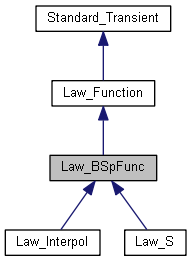|
| | Law_BSpFunc () |
| |
| | Law_BSpFunc (const Handle< Law_BSpline > &C, const Standard_Real First, const Standard_Real Last) |
| |
| GeomAbs_Shape | Continuity () const override |
| |
| Standard_Integer | NbIntervals (const GeomAbs_Shape S) const override |
| | Returns the number of intervals for continuity . May be one if Continuity(me) >=
|
| |
| void | Intervals (TColStd_Array1OfReal &T, const GeomAbs_Shape S) const override |
| | Stores in <T> the parameters bounding the intervals of continuity . The array must provide enough room to accommodate for the parameters, i.e. T.Length() > NbIntervals()
|
| |
| Standard_Real | Value (const Standard_Real X) override |
| | Returns the value of the function at the point of parameter X.
|
| |
| void | D1 (const Standard_Real X, Standard_Real &F, Standard_Real &D) override |
| | Returns the value F and the first derivative D of the function at the point of parameter X.
|
| |
| void | D2 (const Standard_Real X, Standard_Real &F, Standard_Real &D, Standard_Real &D2) override |
| | Returns the value, first and seconde derivatives at parameter X.
|
| |
| Handle< Law_Function > | Trim (const Standard_Real PFirst, const Standard_Real PLast, const Standard_Real Tol) const override |
| | Returns a law equivalent of <me> between parameters <First> and <Last>. <Tol> is used to test for 3d points confusion. It is usfule to determines the derivatives in these values <First> and <Last> if the Law is not Cn.
|
| |
| void | Bounds (Standard_Real &PFirst, Standard_Real &PLast) override |
| | Returns the parametric bounds of the function.
|
| |
| Handle< Law_BSpline > | Curve () const |
| |
| void | SetCurve (const Handle< Law_BSpline > &C) |
| |
 Public Member Functions inherited from Standard_Transient Public Member Functions inherited from Standard_Transient |
| | Standard_Transient () |
| | Empty constructor.
|
| |
| | Standard_Transient (const Standard_Transient &) |
| | Copy constructor – does nothing.
|
| |
| Standard_Transient & | operator= (const Standard_Transient &) |
| | Assignment operator, needed to avoid copying reference counter.
|
| |
| virtual | ~Standard_Transient () |
| | Destructor must be virtual.
|
| |
| virtual const opencascade::handle< Standard_Type > & | DynamicType () const |
| | Returns a type descriptor about this object.
|
| |
| Standard_Boolean | IsInstance (const opencascade::handle< Standard_Type > &theType) const |
| | Returns a true value if this is an instance of Type.
|
| |
| Standard_Boolean | IsInstance (const Standard_CString theTypeName) const |
| | Returns a true value if this is an instance of TypeName.
|
| |
| Standard_Boolean | IsKind (const opencascade::handle< Standard_Type > &theType) const |
| | Returns true if this is an instance of Type or an instance of any class that inherits from Type. Note that multiple inheritance is not supported by OCCT RTTI mechanism.
|
| |
| Standard_Boolean | IsKind (const Standard_CString theTypeName) const |
| | Returns true if this is an instance of TypeName or an instance of any class that inherits from TypeName. Note that multiple inheritance is not supported by OCCT RTTI mechanism.
|
| |
| Standard_Transient * | This () const |
| | Returns non-const pointer to this object (like const_cast). For protection against creating handle to objects allocated in stack or call from constructor, it will raise exception Standard_ProgramError if reference counter is zero.
|
| |
| Standard_Integer | GetRefCount () const noexcept |
| | Get the reference counter of this object.
|
| |
| void | IncrementRefCounter () noexcept |
| | Increments the reference counter of this object.
|
| |
| Standard_Integer | DecrementRefCounter () noexcept |
| | Decrements the reference counter of this object; returns the decremented value.
|
| |
| virtual void | Delete () const |
| | Memory deallocator for transient classes.
|
| |
Law Function based on a BSpline curve 1d. Package methods and classes are implemented in package Law to construct the basis curve with several constraints.

 Public Member Functions inherited from Standard_Transient
Public Member Functions inherited from Standard_Transient